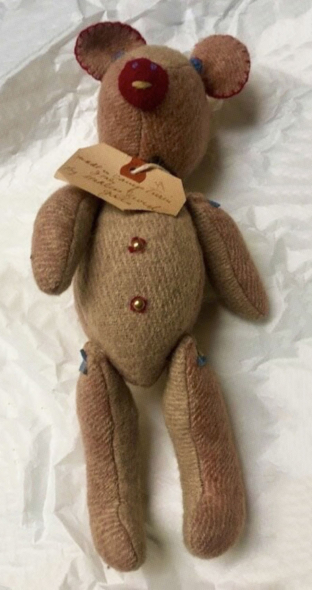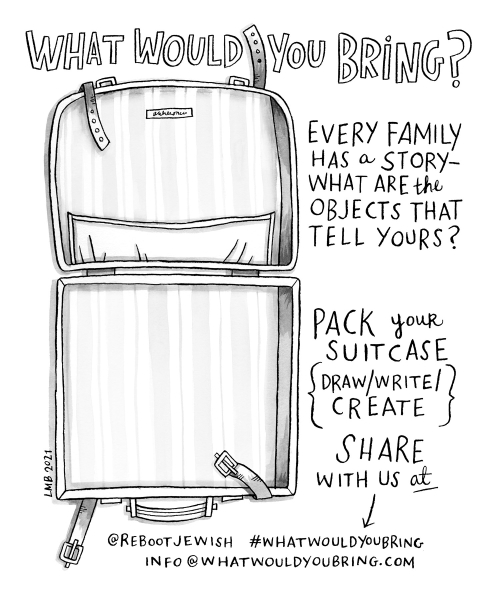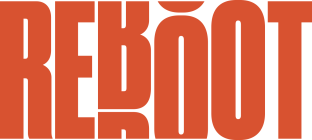Reboot: How My Time in the YIVO Archives Led to the What Would You Bring? Campaign
by JULIET SIMMONS
We have more in common with each other and with refugees than we initially thought.
If you would have asked me three years ago what a researcher might look like, I would not have described myself.
At school I was always a lover of books, but as the years passed, I found myself spending less time researching and more time doing. Perhaps I was just waiting for the perfect opportunity to present itself to me—and in 2019, it did.
As a member of the Jewish arts and culture non-profit organization Reboot, I was invited to participate in a fellowship in New York 6 months before the pandemic. As part of that trip, I got the chance to explore the YIVO and CJH archives.
Before our current reality of lockdowns, reopenings, and vaccination status debates, I used to volunteer at a center for refugees and asylum seekers. I made cups of tea and handed out sandwiches. One week, a friend who also volunteered there told me that she came because her grandfather had been a refugee—and she felt like it was just luck that she was making the tea and not drinking it. My grandfather was a refugee too. I felt the same.
At the refugee center, I’d occasionally chat with the people we were helping if it wasn’t too busy. As we sat together, they’d recall how some of their most precious belongings were things that we might think of as inconsequential. Those conversations made me curious. I began to wonder if there was more that connected those refugees with my grandfather than just luck. Perhaps there were also real tangible objects that connected them too.
So when I was at YIVO, I began to research what refugees had brought from different countries at different times. My deep dive into the archives had begun.
I don’t know what I expected—perhaps piles of papers describing people’s precious belongings—but as I sat in the YIVO Reading Room I was instead presented with piles of boxes filled with teddy bears and dolls, china and books, clothes and more. I began to see that the things that people brought with them before I was born were similar to the things that the drop in center refugees had told me about. I realized that no matter where people came from or during what era they had to flee, the objects that reminded them of home were similar.

The box I most clearly remember opening was one that contained a teddy bear. There was a tag around its neck telling me that it had come to the USA from a Displaced Persons camp in 1947. I had no idea who it belonged to—all I knew was that it was precious to the person who brought it. I imagined that my grandmother had probably had a similar bear when she was a child and thought of my own toys too.
The outcome of my participation in that fellowship, and specifically my time at YIVO, led to the launch of an oral history project that I created with the support of the team at Reboot entitled What Would You Bring? It asks people to stand in the shoes of refugees and to consider what they would choose to bring with them if they were forced to flee their homes. The project has led me to speak with many refugees who have generously shared their stories and objects with me. Each of these deeply personal testimonies touch upon not only what was brought, but also what was left behind. Collectively, these stories show just how connected we all are.
One of the stories that we feature as part of What Would You Bring? comes from John Hajdu. John’s story is quite remarkable—he survived Nazi occupation and a communist revolution escaping to the UK—and his teddy bear was the one constant in his life. His bear was not my YIVO bear—and yet I felt that they were connected, as both bears mattered so much to the people that owned them.
We live in a time of mass consumerism, where too many of us have too much stuff. But imagine if you had to suddenly leave—what would you grab and take with you? It might be photos, or a toy, a piece of jewelry—or even a piece of china that you could use every time you made a cup of tea. Whatever you might choose, it’s likely that a modern day refugee or someone from the past chose something similar. It’s a reminder that the things that matter to us as human beings transcend cultures, borders and history.

I don’t know the stories of all the objects that I discovered at YIVO, I just know that those objects mattered enough to their owners for them to be brought and saved in the archives. They spoke to me in a way I can’t meaningfully articulate, but they led me to other stories and the creation of a platform that allows me to continue sharing the stories of refugees today.
Although I’m not sure what my grandfather brought with him when he came from Vienna to the UK, this project can help us all discover what other grandfathers, parents, and friends brought with them and allow us to share their stories. And in the end, it’s a reminder that the objects that we care about connect us, reinforcing the idea that during a time of rampant xenophobia and othering of marginalized groups, we have more in common with each other and with refugees than we initially thought.
So please share your family’s story with us:
Juliet Simmons is the creator of What Would You Bring?






